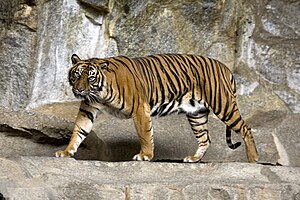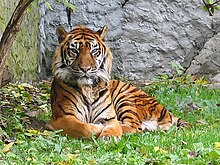Sumatran tiger
| Sumatran tiger | ||||||||||||
|---|---|---|---|---|---|---|---|---|---|---|---|---|

Sumatran tiger ( Panthera tigris sumatrae ) |
||||||||||||
| Systematics | ||||||||||||
|
||||||||||||
| Scientific name | ||||||||||||
| Panthera tigris sumatrae | ||||||||||||
| Pocock , 1929 |
The Sumatran tiger ( Panthera tigris sumatrae ) is the smallest living subspecies (subspecies) of the tiger , which occurs exclusively on the Indonesian island of Sumatra . Like the extinct subspecies of the Bali ( Panthera tigris balica ) and Java tiger ( Panthera tigris sondaica ), the Sumatran tiger is one of the so-called island subspecies. It is one of the rarest tiger subspecies and is listed by the IUCN ( International Union for Conservation of Nature and Natural Resources ) as " Critically Endangered " .
features
DNA analyzes showed that the Sumatran tiger genetically differs greatly from all subspecies still alive today and is therefore taxonomically opposed to the group of these mainland tiger subspecies . This result is consistent with the assumption that the Sumatran tiger at the transition from the Pleistocene to the Holocene was isolated on Sumatra about 12,000 to 6,000 years ago when the sea level rose with rewarming after the last Ice Age.
anatomy
It is the smallest living subspecies of the tiger. The largest is the Siberian tiger ( Panthera tigris altaica ). The Sumatran tiger male has a total length (including tail) of 240 cm to 250 cm and a weight of 100 to 140 kg. The total body length of the female tiger is between 215 cm and 230 cm and their body weight is 75 to 90 kg. The shoulder height is approx. 60 cm to 75 cm, whereas the Siberian tiger reaches up to 110 cm shoulder height.
In the shape of the skull, the Sumatran tiger clearly differs from the insular subspecies of the Bali and Java tigers in terms of the occipital region (back of the head) and the nasal bones. In its width, the occiput of the Sumatran tiger is similar to that of the mainland subspecies. The nasal bones are much shorter and wider compared to the Bali and Java tigers. The general characteristic with the insular subspecies, however, is the sagittal bone crest, which is less developed than with continental subspecies.
hide
The fur of the Sumatran tiger is short and, like the other insular, southern subspecies, has a very strong basic coat color. This varies from a very dark orange to reddish-dark ocher colors. The light color of the Sumatran tiger on the belly or the inside of the legs is never pure white, as is the case with the King Tiger or Siberian tiger , for example , but rather cream-colored. The very dark overall impression of the fur is reinforced by the stripes, which are deep black, very wide and sometimes doubled or even tripled. At the end of the drawing, the stripe drawing changes into spots, as is the case with all southern species. The drawing is also very pronounced on the front legs. In comparison, the mainland subspecies rarely have one or two horizontal stripes on the front legs, while these are regular in the Sumatran tiger. Compared to other subspecies of the tiger, the Sumatran tiger has more expressive and denser stripes on the inside and back of the front legs. The number of tail rings is eight to ten, although these are usually doubled. The base of the tail has an elongated pattern and consists of two to three irregular stripes or rings.
The hair of the Sumatran tiger has a length of 10 to 15 mm, whereby a mane is often indicated in the male tiger. The length of the hair on the neck is between 110 and 130 mm, and the fur on the chest is comparatively longer than on the rest of the body. The whiskers, the hair length of which can be 80 to 120 mm, is particularly pronounced in this subspecies and thus underlines the mane-like overall impression of the animal. The coat changes twice a year.
particularities
Like the jaguar living in Central and South America and all tiger subspecies, the Sumatran tiger is not afraid of water and is a very good swimmer. The peculiarity of this subspecies is that it has webbed toes.
distribution and habitat

The habitat of the Sumatran tiger is the tropical rainforest : the peat bog, lowland and highland rainforests of the sixth largest island in the world are the natural habitat of these big cats . It is endemic , which means it only lives on the Indonesian island of Sumatra. It is the southernmost and smallest subspecies of the tiger. The Sumatran tiger was once widespread across the island. Today he finds an important refuge in the Barisan Selatan National Park , a World Heritage Site on the southern tip of the island. No current information is available about the occurrences in the Gunung Leuser National Park in northern Sumatra. In the Indonesian National Park Bukit Tigapuluh , pictures of 12 Sumatran tigers were made, which the WWF ( World Wildlife Fund ) published on May 9, 2011.
Way of life

nutrition
The prey spectrum of the Sumatran tiger includes large and small mammal species (ungulates), more rarely water birds or reptiles.
Reproduction and lifespan
The Sumatran tiger's gestation period is a maximum of 100 days, which is slightly below the average gestation period of around 105 days observed in other subspecies. The reason for this is his smaller physique. The development corresponds to that of other subspecies of the tiger. A litter has an average of two young. The lifespan in the wild, like other subspecies, is up to 15 years, while the Sumatran tiger can live to be over 20 years old in captivity.
Threat and protection
By 1940 Sumatra was already the third largest supplier of rubber in the world. The Sumatran tiger was only massively endangered after the Second World War . After 1945, not only was the tiger habitat increasingly opened up for the benefit of agriculture, such as palm oil plantations for world trade. The trade in tiger parts for traditional Asian medicine or so-called "tiger wine" increased considerably in addition to hunting the big cats because of their fur.
As for all subspecies of the tiger, constant loss of habitat through humans, poaching and the decimation of prey are the greatest threats to this species. According to WWF, tigers are endangered because "[...] the paper and pulp industry [urges] that the Indonesian state permits it to be cleared . ”While there were around 1000 wild Sumatran tigers in the 1970s, in 1996, according to the IUCN, there were only 250 adult animals with a decreasing trend. According to IUCN (2009), at least 51 animals were killed annually from 1998 to 2002, 76% of which were mainly for trade. According to current research, however, habitat changes by humans also pose a not inconsiderable threat to the Sumatran tiger. The observations showed that the tigers in their areas feel disturbed by increasing human activities, even if tigers are generally considered to be very adaptable. It was particularly noticeable that there were few tigers in these areas, although the population of potential prey was quite high.
According to population estimates by the WWF, the number of Sumatran tigers is 400, but due to the fragmentation and limitation of the territories or assigned territories, they live in genetically isolated populations. About 200 Sumatran tigers live in zoological gardens, of which about 100 are in Europe. The Sumatran tiger is considered due to its low component count as "threatened with extinction" (CR - Critically Endangered ).
Hunting the Sumatran tiger is prohibited under Indonesian law. The Washington Convention on International Trade in Endangered Species of Wild Fauna and Flora ( CITES ) prohibits international commercial trade in tiger products in Appendix I. The Sumatran tiger is an animal of the European Conservation Breeding Program (EEP), which is an international, zoo-spanning project for the conservation of animal species threatened by extinction, due to its species that is about to become extinct. The international stud book for Sumatran tigers is kept by the Zoological Society of London , which monitors and coordinates the genetic allocation of the animals to the zoos.
Tigers and humans in Sumatra
"In Indonesia, Muslims believed that Allah gave the tiger the power to protect the believers and punish anyone who dared to break the laws of Islam." The tiger was feared as a spirit and a devout Muslim could ride a tiger, like a Taoist sage. However, old customs and traditions are increasingly a thing of the past, so that due to the global economic development, the tiger is also massively hunted here for the fur trade and traditional Asian medicine, regardless of beliefs and traditions.
Since the decimation of the big cat's habitats through deforestation, and consequently through the loss of natural prey, the often fatal attacks on humans have increased as the tiger is now confronted with areas inhabited and cultivated by humans. The attacks of Sumatran tigers on humans, however, are as frequent as they are not of royal tigers (Bengaltigern) from the Sundarbans in India and Bangladesh are reported.
literature
- Peter Matthiessen : Tiger in the snow. A plea for the Siberian tiger. National Geographic, Goldmann, Munich 2000, ISBN 978-3-492-40201-9 , pp. 86-92.
- Vratislav Mazák : The tiger. Panthera tigris . Reprint of the 3rd edition from 1983. Westarp Wissenschaften Hohenwarsleben, 2004 ISBN 3-89432-759-6 , pp. 164-168.
- Ronald M. Nowak: Walker's Mammals of the World. Johns Hopkins University Press, 1999 ISBN 0-8018-5789-9 .
Web links
- Species profile Sumatran tiger; IUCN / SSC Cat Specialist Group (English)
- Sumatran tiger (Panthera tigris sumatrae) in the WWF species lexicon
- Chris R. Shepherd, Nolan Magnus: TRAFFIC Southeast Asia: Nowhere to hide. The Trade in Sumatran Tiger . 2004 (English; PDF; 958 kB)
Individual evidence
- ↑ Cracraft J., Feinstein J., Vaughn J., Helm-Bychowski K .: Sorting out tigers ( Panthera tigris ) Mitochondrial sequences, nuclear inserts, systematics, and conservation genetics . In: Animal Conservation . 1, 1998, pp. 139-150. doi : 10.1111 / j.1469-1795.1998.tb00021.x .
- ^ Vratislav Mazák: The tiger. Panthera tigris. P. 168.
- ^ Vratislav Mazák: The tiger. Panthera tigris. P. 165
- ^ Vratislav Mazák: Panthera tigris. In: Mammalian Species. No. 152, pp. 1-8.
- ^ Vratislav Mazák: The tiger. Panthera tigris. P. 165
- ↑ a b Species portrait: Sumatran tiger (Panthera tigris sumatrae). (PDF) WWF Germany , December 2009, accessed on April 29, 2016 .
- ↑ a b Animal nursery: camera trap films three young tigers playing. In: WWF . Retrieved August 23, 2012 .
- ↑ Peter Matthiessen: Tiger in the snow. A plea for the Siberian tiger. Pp. 86-87.
- ^ Sumatran tiger population threatened by human activities. In: Zeenews.com , June 30, 2013
- ↑ Asim is here: Young Sumatran tiger has arrived at Heidelberg Zoo ( Memento of the original from March 4, 2016 in the Internet Archive ) Info: The archive link has been inserted automatically and has not yet been checked. Please check the original and archive link according to the instructions and then remove this notice. Heidelberg Zoo
- ↑ Panthera tigris ssp. sumatrae in the endangered Red List species the IUCN 2007. Posted by: Cat Specialist Group, 1996. Retrieved on 22 May, 2008.
- ↑ Panthera tigris sumatrae. ( Memento of the original from November 4, 2016 in the Internet Archive ) Info: The archive link was inserted automatically and has not yet been checked. Please check the original and archive link according to the instructions and then remove this notice. European conservation breeding program EEP
- ^ Sumatran tigress moves to the Augsburg zoo. Association of German Zoo Directors V., accessed on May 28, 2014
- ↑ Peter Matthiessen: Tiger in the snow. A plea for the Siberian tiger. P. 87.
- ↑ Peter Matthiessen: Tiger in the snow. A plea for the Siberian tiger. P. 88.
- ↑ Peter Matthiessen: Tiger in the snow. A plea for the Siberian tiger. P. 90.



